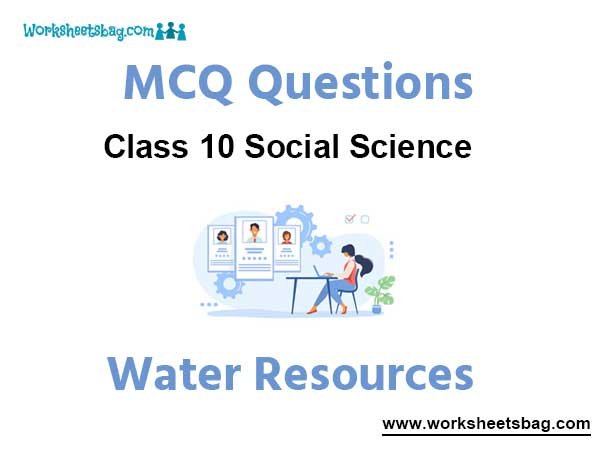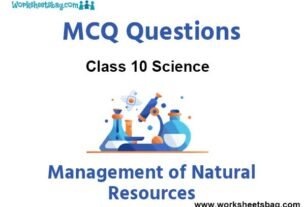Please refer to Water Resources MCQ Questions Class 10 Social Science below. These MCQ questions for Class 10 Social Science with answers have been designed as per the latest NCERT, CBSE books, and syllabus issued for the current academic year. These objective questions for Water Resources will help you to prepare for the exams and get more marks.
Water Resources MCQ Questions Class 10 Social Science
Please see solved MCQ Questions for Water Resources in Class 10 Social Science. All questions and answers have been prepared by expert faculty of standard 10 based on the latest examination guidelines.
MCQ Questions Class 10 Social Science Water Resources
Question. Which options are true for dams?
(a) They check the sediment flow in rivers.
(b) Dams have helped provide ample water for agriculture.
(c) Dams have solved problems of drought in Central India.
(d) Dams have helped in power generation.
Answer
B
Question. The Narmada Bachao Andolan is associated with
(a) Sardar Sarovar Dam
(b) Tehri Dam
(c) Hirakund Dam
(d) Gandhi Sagar Dam
Answer
A
Question. Which of the following river projects or groups of river projects provide hydroelectricity to the industries of Maharashtra?
(a) Pravara Project and Koyna Project
(b) Hirakud Project
(c) Nagarjuna sagar Project and Tungabhadra project
(d) Ghataprabha Project and Mettur Project
Answer
A
Question. Due to which of the following reasons are rooftop rainwater harvesting commonly practiced particularly in Rajasthan?
(a) To store water for irrigation
(b) To keep house cool
(c) To store drinking water
(d) To clean rooftop
Answer
C
Question. Most farmers own wells and tube wells and their farms for irrigation to increase their production, what adverse effect can this have?
(a) Falling groundwater levels, adversely affecting water availability
(b) Imbalance in minerals for soil
(c) Unequal distribution of water
(d) Could be technical defaults
Answer
A
Question. Post-independence India witnessed intensive _____________.
(a) agriculture
(b) economic problems
(c) industrialization and urbanization
(d) deforestation
Answer
C
Question. How did the increasing number of industries affect the water condition?
(a) No effect on water
(b) Pressure on existing freshwater
(c) Balance between use of water and industry
(d) Unequal distribution of water
Answer
B
Question. In India hydroelectric power contributes approximately ___________ percent of the total electricity produced.
(a) 22
(b) 25
(c) 20
(d) 26
Answer
A
Question. Which factors have aggravated the water and energy problems in India?
(a) Multiplying urban centers
(b) Dams
(c) Afforestation
(d) Agriculture
Answer
A
Question. What are the causes for the Indian rivers to become toxic?
(a) Fossils
(b) Agricultural
(c) Conservation of water
(d) Industrialization
Answer
D
Question. Which of the following is not cause of water scarcity?
(a) Growing population
(b) Growing water intensive crop
(c) Expansion of irrigational facility
(d) Water harvesting techniques
Answer
D
Question. Which of the following is a reason for water scarcity in a region with sufficient water to meet the requirements of the people?
(a) Huge population
(b) Less rainfall
(c) Power requirement
(d) Pollution
Answer
D
Question. What are the important things to do to prevent degradation of our natural ecosystems?
(a) Urbanization
(b) Industrialization
(c) Conserve and manage our water resources to safeguard ourselves from health hazards
(d) Modern agriculture
Answer
C
Question. What will impoverish this water resource and cause an ecological crisis that may have a profound impact on our lives?
(a) Industrialization
(b) Modern agriculture
(c) Urbanization
(d) Over exploitation and mismanagement of water resources
Answer
D
Question. Rana Pratap Sagar Dam is located in
(a) Odisha
(b) Uttarakhand
(c) Rajasthan
(d) Andhra Pradesh
Answer
C
Question. Salal Dam is built on which river?
(a) Chenab
(b) Mahanadi
(c) Krishna
(d) Satluj
Answer
A
Question. Jawaharlal Nehru proudly proclaimed the dams as the _______________.
(a) saviors of India
(b) temples of modern India
(c) future of India
(d) complexes of India
Answer
B
Question. Which of the following state governments have raised the Krishna-Godavari dispute?
(a) Karnataka and Andhra Pradesh
(b) Gujarat and Rajasthan
(c) Maharashtra and Madhya Pradesh
(d) Karnataka and Maharashtra
Answer
A
Question. Oceans contain _________ percent volume of water.
(a) 90 percent
(b) 75 percent
(c) 96.5 percent
(d) 98 percent
Answer
C
Question. Bamboo drip irrigation system is prevalent in
(a) Manipur
(b) Meghalaya
(c) Mizoram
(d) Madhya Pradesh
Answer
B
Question. What is the purpose of building dams?
(a) For embankment
(b) Flood control
(c) Storage
(d) Water animals’ conservation
Answer
B
Question. What percentage of the total volume of world’s water is estimated to exist as oceans?
(a) 94.5%
(b) 95.5%
(c) 96.5%
(d) 97.5%
Answer
C
Question. Rooftop rainwater harvesting is a technique to recharge-
(a) ground water
(b) river water
(c) lake water
(d) sea water
Answer
A
Question. How much of earth’s surface is covered with water?
(a) One-fourth
(b) Half
(c) Three-fourth
(d) Two-third
Answer
C
Question. In which of the following regions, people built Guls and Kuls for irrigation?
(a) Northern Plains
(b) Western Himalayas
(c) Coastal areas
(d) None of the above
Answer
B
Question. Which among the following is a multi-purpose dam which is used for conservation of water with flood control?
(a) Satluj-Beas river basin
(b) Bhakra-Nangal Project
(c) Hirakud Project
(d) Tehri Dam
Answer
C
Question. Why did Jawaharlal Nehru call dams as Temples of Modern India?
(a) They were multi-purpose in nature.
(b) Irrigation became better.
(c) Development of agriculture and the village economy with rapid industrialization and growth of the urban economy.
(d) Hydel power became ample.
Answer
C
Question. Which of the following remote backward village in Mysore, Karnataka installed household rooftop rainwater harvesting system?
(a) Gendathur
(b) Vanasthalipuram
(c) Chilkunda
(d) Kallahalli
Answer
A
Question. In which part of India, rooftop rainwater harvesting is the most common practice?
(a) Uttar Pradesh
(b) Kerala
(c) Rajasthan
(d) Shilong
Answer
D
Question. Different social groups do not have _________ access to water.
(a) special
(b) equal
(c) different
(d) none of the above
Answer
B
Question. Tehri Dam Aandolan is mainly concerned with the state of
(a) Uttarakhand
(b) Jharkhand
(c) Chhattisgarh
(d) None of these states
Answer
A
Question. Multi-purpose dams were launched in India after _________.
(a) 1957
(b) independence
(c) 1962
(d) none of the above
Answer
B
Question. Who are benefitted from the multi-purpose projects?
(a) Landowners, large farmers and industrialists
(b) Local people
(c) Government
(d) The builders
Answer
A
Question. Which of the following areas were farmers agitation when higher priority was given to water supply in urban areas, particularly during drought?
(a) Krishna-Godavari basin
(b) Konya basin, Maharashtra
(c) Sabarmati basin, Gujarat
(d) Rihand basin, Uttar Pradesh
Answer
C
Question. In which of the following areas are ‘guls’ and ‘kuls’ used to channel water for agriculture?
(a) Deccan Plateau
(b) Deserts of Rajasthan
(c) Western Himalayas
(d) Ganga Plains
Answer
C
Question. Narmada Bachao Andolan or Save Narmada Movement originally focused on-
(a) irrigation strategies
(b) environmental issues related to trees
(c) aim to enable poor citizens, especially the outsees
(d) reservoir planning
Answer
B
Question. In which one of the following states palar pani is considered the purest form of natural water?
(a) Gujarat
(b) Rajasthan
(c) Madhya Pradesh
(d) Chhatitisgarh
Answer
B
Question. Underground tanks seen in Rajasthan to store rainwater for drinking is called-
(a) Tankas
(b) Khadin
(c) Ponds
(d) Kuls
Answer
A
Question. Nagarjuna Sagar Dam is built on which river?
(a) Chenab
(b) Mahanadi
(c) Krishna
(d) Satlej
Answer
C
Question. On which of the following issues did the Narmada Bachao Andolan first focus?
(a) Benefits of irrigation to landless farmers
(b) Environmental issues related to submergence of trees under the dam water
(c) Rehabilitation of the people displaced due to construction of the dam
(d) Economic issues of wastage of money for the construction of the dam
Answer
B



